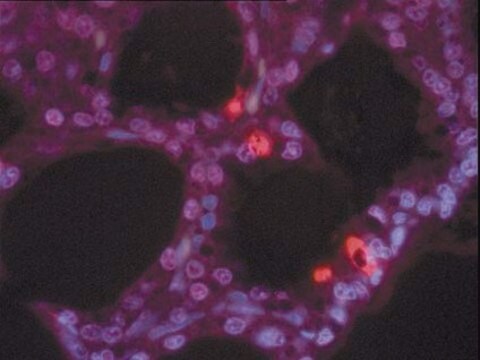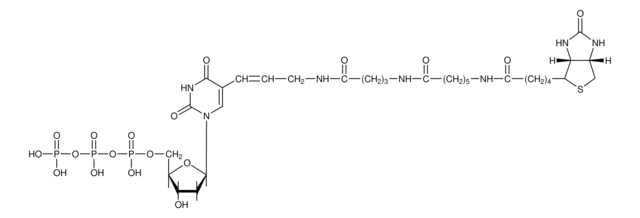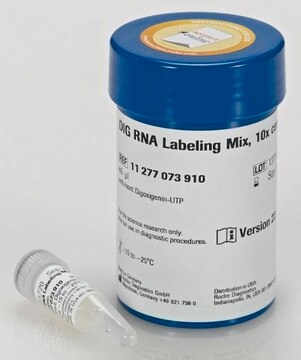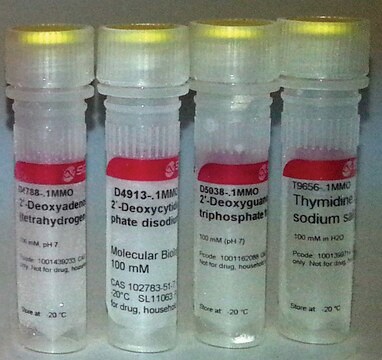RTT-RO
Roche
Terminal Transferase
from Calf Thymus, recombinant, E. coli
About This Item
Productos recomendados
recombinant
expressed in E. coli
Quality Level
form
solution
usage
sufficient for 20 reactions (03333566001)
sufficient for 60 reactions (03333574001)
packaging
pkg of 24,000 U (03333574001 [400 U per reaction])
pkg of 8,000 U (03333566001 [400 U per reaction])
manufacturer/tradename
Roche
application(s)
genomic analysis
storage temp.
−20°C
General description
Application
- Tailing with dNTPs:Addition of homopolymeric tails to DNA fragments
- Labeling of double- and single-stranded DNA and oligonucleotides with either radioactive or chemically modified nucleotides (e.g., DIG-dUTP)
Labeling of double- and single-stranded DNA and oligonucleotides with either radioactive or chemically modified dideoxynucleotides (e.g., DIG-ddUTP)
Features and Benefits
In addition to standard nucleotides, terminal transferase wlll add radioactive or modified (e.g., digoxigenin-, biotin-, or fluorochrome-labeled) dNTPs or ddNTPs to DNA.
Packaging
Quality
Principle
Unit Definition
Unit Assay: Unit assay conditions: 200 mM Potassium cacodylate, 1 mM CoCl2, 1 mM dTTP, 0.1 OD d(pT)6, 6.25 pmol 3H dTTP in a 120 μl reaction volume.
Volume Activity: 400 U/μl
Sample Materials
- Double- or single-stranded DNA fragments
- Double- or single-stranded oligonucleotides
Preparation Note
Preparation of CoCl2 working solution
Add in a sterile vial 10 μl double dist. water and 15 μl of the supplied 25 mM CoCl2 solution: Final concentration: 15 mM
Preparation of radioactive labeling mix
dATP and dTTP labeling mix: mix 1 Vol. of a 2.5 mM dATP or dTTP solution with 15 volumes of double-distilled water and 4 volumes of α-32P-dATP or α-32P-dTTP (800 Ci/mmol, approx. 30 TBq/mmol).
dGTP and dCTP labeling mix: mix 1 volume of a 2 mM dGTP or dCTP solution with 15 volumes of double-distilled water and 4 volumes of α-32P-dGTP or α-32P-dCTP (800 Ci/mmol, approx. 30 TBq/mmol)
Other Notes
Solo componentes del kit
- Terminal Transferase 400 U/μl
- TdT Reaction Buffer 5x concentrated
- CoCl<sub>2</sub> Solution 25 mM
signalword
Danger
Hazard Classifications
Acute Tox. 4 Inhalation - Acute Tox. 4 Oral - Aquatic Chronic 2 - Carc. 1B Inhalation - Repr. 1B
Storage Class
6.1D - Non-combustible, acute toxic Cat.3 / toxic hazardous materials or hazardous materials causing chronic effects
wgk_germany
WGK 3
flash_point_f
does not flash
flash_point_c
does not flash
Elija entre una de las versiones más recientes:
¿Ya tiene este producto?
Encuentre la documentación para los productos que ha comprado recientemente en la Biblioteca de documentos.
Los clientes también vieron
Nuestro equipo de científicos tiene experiencia en todas las áreas de investigación: Ciencias de la vida, Ciencia de los materiales, Síntesis química, Cromatografía, Analítica y muchas otras.
Póngase en contacto con el Servicio técnico











